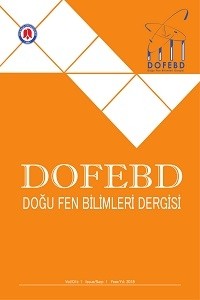SiC Takviyeli Cu-Al-Ni Kompozitlerinin Üretiminde Toz Metalurjisi Yönteminin Kullanımı ve Üretim Sonucunun Karakterizasyonu
Toz metalurjisi (TM), alaşımların önemli bir üretim yolu olup, özellikleri ve ekonomisi açısından da önemlidir. Bu yöntem, karmaşık ve çok yönlü şekil ve yapıların üretimi için uygundur. Bu çalışmada, sabit presleme ve sabit sıcaklıkta sinterlenen CuAlNi ve CuAlNi-SiC alaşımlarının mikroyapısı ve mekanik özellikleri iyileştirilmeye çalışılmıştır. Kompozit numuneler, CuAlNi toz karışımına mikron seviyesinde farklı ağırlık oranlarında (%2,5, 5, 7,5 ve %10) SiC tozları ilave edilerek PM yöntemi ile üretilmiştir. Üretilen numunelerin mikro yapılarını belirlemek için taramalı elektron mikroskobu (SEM) ve optik mikroskop, iç yapılarında oluşan fazları belirlemek için X-Işını Floresan (XRF) ve X-Işını Kırınım yöntemi (XRD) analizleri kullanılmıştır. Sertlik etkisini belirlemek için mikro sertlik (HV5) alınmıştır. Mikro yapı sonuçlarına göre, SiC partikülleri yapı içinde homojen olarak dağılmıştır. Artan SiC takviyesine bağlı olarak sertlik değerlerinde artış gözlenmiştir.
Anahtar Kelimeler:
Toz Metalurjisi, Kompozit malzemeler, SiC
Use Of Powder Metallurgy Method in The Production of SiC Reinforced Cu-Al-Ni Composites and Characterization of The Production Result
Powder metallurgy (PM) is an important production route of alloys and is also important in terms of its properties and economy. This method is suitable for the production of complex and versatile shapes and structures. In this study, it was tried to improve the microstructure and mechanical properties of CuAlNi and CuAlNi-SiC alloys sintered at constant pressing and constant temperature. Composite samples were manufactured by the PM method by supplementing the CuAlNi powder mixture with SiC powders at different weight ratios (2.5%, 5, 7.5 and 10%) at the micron level. Scanning electron microscope (SEM) and optical microscope were used to determine the microstructures of the manufatured samples, and X-Ray Fluorescence (XRF) and X-Ray Diffraction method (XRD) analyzes were used to determine the phases formed in their internal structures. Micro hardness (HV5) was taken to determine the hardness effect. According to the micro structure results, SiC particles were homogeneously dispersed in the structure. Depending on the increasing SiC reinforcement, an increase in hardness values was observed.
Keywords:
Powder metallurgy, Composite materials, SiC,
___
- Akbarpour, M., Najafi, M., Alipour, S., & Kim, H. (2019). Hardness, wear and friction characteristics of nanostructured Cu-SiC nanocomposites fabricated by powder metallurgy route. Materials today communications, 18, 25-31.
- Atapek, Ş. H., Pantelakis, S., Polat, Ş., Chamos, A., & Çelik, G. A. (2020). Fatigue behavior of precipitation strengthened Cu–Ni–Si alloy modified by Cr and Zr addition. International Journal of Structural Integrity.
- Azaath, L. M., Natarajan, U., Veerappan, G., Ravichandran, M., & Marichamy, S. (2022). Experimental Investigations on the Mechanical Properties, Microstructure and Corrosion Effect of Cu-20Al-4Ni/SiC Composites Synthesized Using Powder metallurgy Route. Silicon, 14(11), 5993-6002.
- Çalıgülü, U., Taşkın, M., & Kejanlı, H. (2008). Soğuk Presleme Yöntemiyle Üretilmiş Ni-Ti-Cu Kompozitlerin TLP Difüzyon Kaynağında Sıcaklığın Birleşme Üzerindeki Etkisinin İncelenmesi. Engineering Sciences, 3(4), 558-570.
- Dash, A., Sohn, Y. J., Vaßen, R., Guillon, O., & Gonzalez-Julian, J. (2019). Synthesis of Ti3SiC2 MAX phase powder by a molten salt shielded synthesis (MS3) method in air. Journal of the European Ceramic Society, 39(13), 3651-3659.
- Dileep, B., Ravikumar, V., & Vital, H. (2018). Mechanical and corrosion behavior of Al-Ni-Sic metal matrix composites by powder metallurgy. Materials Today: Proceedings, 5(5), 12257-12264.
- Kim, H., Ahn, J. H., Han, S. Z., Jo, J., Baik, H., Kim, M., & Han, H. N. (2020). Microstructural characterization of cold-drawn Cu–Ni–Si alloy having high strength and high conductivity. Journal of Alloys and Compounds, 832, 155059.
- Lei, Q., Li, S., Zhu, J., Xiao, Z., Zhang, F., & Li, Z. (2019). Microstructural evolution, phase transition, and physics properties of a high strength Cu–Ni–Si–Al alloy. Materials Characterization, 147, 315-323.
- Salur, E., Aslan, A., Kuntoğlu, M., & Acarer, M. (2021). Effect of ball milling time on the structural characteristics and mechanical properties of nano-sized Y2O3 particle reinforced aluminum matrix composites produced by powder metallurgy route. Advanced Powder Technology, 32(10), 3826-3844.
- Şap, S., Usca, Ü. A., Uzun, M., Kuntoğlu, M., & Salur, E. (2022). Performance evaluation of AlTiN coated carbide tools during machining of ceramic reinforced Cu-based hybrid composites under cryogenic, pure-minimum quantity lubrication and dry regimes. Journal of Composite Materials, 56(22), 3401-3421.
- Wang, W., Guo, E., Chen, Z., Kang, H., Chen, Z., Zou, C., . . . Wang, T. (2018). Correlation between microstructures and mechanical properties of cryorolled CuNiSi alloys with Cr and Zr alloying. Materials Characterization, 144, 532-546.
- Wu, R., Zhou, K., Yang, Z., Qian, X., Wei, J., Liu, L., . . . Wang, L. (2013). Molten-salt-mediated synthesis of SiC nanowires for microwave absorption applications. CrystEngComm, 15(3), 570-576.
- ISSN: 2667-6958
- Yayın Aralığı: Yılda 2 Sayı
- Başlangıç: 2018
- Yayıncı: Hakkari Üniversitesi
Sayıdaki Diğer Makaleler
Rüstem BİNALİ, Mustafa KUNTOĞLU
Hasan KAÇAN, Khangardash ASGAROV, Tayfun ÇETİN, Rüstem BİNALİ
Beyin Homeostazında Bakır, Demir, Çinko Elementlerinin Parkinson Hastalığı ile İlişkisi
Gizem YATKIN, Seda KUŞOĞLU GÜLTEKİN, İrem Gülfem ALBAYRAK, Belkis ATASEVER ARSLAN
Mehmet FİDAN, Süleyman Mesut PINAR, Mehmet Emre EREZ, Behcet İNAL
Iris zagrica subsp. zagrica (Iridaceae); A New Record Localty for the Flora of North Iraq
Hızlı Prototiplemeye Yönelik Termal Dayanımlı Elektromanyetik Kalkan Özellikli Filament Üretimi
